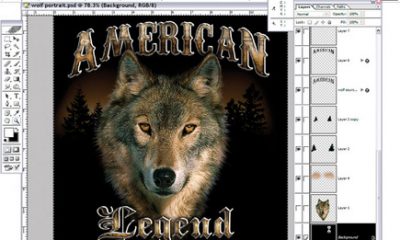Digital Printing
Published
18 years agoon
The decision to quote either digital or screen printing is a dark abyss salespeople must venture into when estimating projects for clients. Many look for the easy way out by telling customers they'll quote prices for both imaging methods and determine which one is cheaper. Cheaper? As in negative, in the red, losing revenue, and leaving money on the table? Cheaper? I shiver to think. Cheaper, in this context, should make every businessperson cringe. Is estimating just adding up labor, materials, outside services, and mark up? Where's the value?
Rethinking our approach
Take the statement, "Let me quote screen and digital and see which one comes out cheaper," out of the sales vernacular. Instead, let's focus on decision-making factors with real substance. Four parameters assist us in selecting the appropriate imaging method for the job at hand: required quality, commitment of equipment and staff, the actual estimate, and timing.
Required quality We have lots of factors to consider here. If screen printing won't support the resolution needed for halftones, look to digital. If the text in the graphics is too small to be printed digitally, head for the screen presses. Is a matched PMS color critical to the job? The work could either go screen or digital these days. Quality isn't so cut and dry when making the big decision. Screen and digital have their strengths and weaknesses, so we must be sure to review the graphics carefully with our equipment's capabilities in mind.
Commitments Do managers either inadvertently or purposely maintain a bias in order to keep expensive equipment running? If we can't sleep until we know our million-dollar presses are moving, then we're probably clouding our own decisions. Are our hourly rates twisted to push a particular imaging method? I've seen the rationalization of hourly rates used to justify high and low prices. The justification can range from a percent of billable hours or capacity or simply using the rate that the competition uses.
The actual estimate The estimate has to be 1+1 with no wiggle room: labor rate + equipment rate + outside costs + administrative costs + mark up. The equipment rate is completely dependent on how long we allow for return on investment. And what is the return? Break even? Twenty percent? These decisions can double and triple the hourly rate for equipment.
Quotes for screen printing tend to be itemized in great detail—prepress, screen making, make ready, and printing. In digital, the costs of prepress and make ready are usually absorbed into the printing costs. Cost per square foot is gospel in digital, but this model has ruined our market. I know we can blame some segment of the graphics industry that introduced that hideous box that our clients throw us all into for quick comparison. Square footage will always stay the same. It's the prepress/setup costs that actually are added. So, what is the setup cost? Is it the same for every job? That box feels oh so confining.
Timing Timing can be a substantial influence in our decision about whether to screen print a job or produce it digitally. The number of versions, type and number of proofs required, prepress and press-setup concerns, and the final due date are all important considerations. Knowing the time requirements of the job when we sit down to estimate the price not only helps us determine which imaging method is better suited, but also allows us to explore other ways of adding value to the project.
How some shops decide
I recently polled four types of screen printers who also have digital-imaging capabilities to see how they decide which technology to use. My survey was certainly unscientific, but all four shops have high-end digital and screen equipment.
The fleet-graphics printer quotes all four-color jobs as digital. Screen printing becomes an option only when the number of trucks jumps. He believes that process-color screen printing is more technically demanding and must be practiced daily in order to achieve the best results. Because most full-color fleet jobs don't have the quantities to justify screen printing, he finds it more sensible to use digital imaging for all fleet work.
He mentioned two concepts that back up his reasoning: panel matching and generation of press proofs. Both require a degree of accuracy and repeatability that can be achieved much more easily with digital printing.
The P-O-P printer I contacted uses digital imaging to service clients' short runs and customized jobs. This printer won't even look at her screen-printing equipment when run sizes are fewer than 200 large sheets. She doesn't want to tie up her inline presses for small quantities.
Straight numbers is the game for the banner printer. This is a market of very tight margins and even tighter quotes. Quantity determines the winner here. Finally, the garment printer I contacted indicated that digital printing has almost eliminated four-color-process screen printing in his shop. Digital printing allows the shop to generate accurate proofs, produce customized garments, and handle very short runs. Line work, which he said is 80% of his volume, goes to the screen presses.
Value
Now that we've outlined decision-making parameters and have heard from some printers, let's get real about value. The duty of sales reps is to present the company as a value. I truly do understand that clients tend to ask for capabilities and equipment lists. Value selling steers this inquiry toward final products that emphasizes company strengths. Strengths may be in turnaround time, customer service, custom graphics, or one-stop shopping. Focusing only on equipment puts printers back into the little box.
Next is information. Do we know what the image is? Not often—and seldom do we ask. Could we add value by pushing to see the image during the quoting stage? Most definitely. Do we usually have a feel of timing? No. Hey, this is a quote against three competitors, so timing doesn't matter yet! Could we add value to this scenario with some understanding of timing? You bet.
Now, the numbers are the numbers, right? Sometimes. Digital may hold more value, and the market may bear additional markup. We want to avoid leaving money on the table. Can we add value to our business? All the time. Do we want to be low-cost suppliers, or is service and value the mantra of our businesses?
No one should ever suggest quoting screen and digital just to see which one comes out cheaper. Management should review quotes for what will add value for the client and add value to the business. The decision should be specific and explained to the client as a value proposition. Salespeople tend to look for the least costly way to bid. Nervousness about selling on value rather than cost will always exist; however, success in selling value will breed more success. Reps do not want to lose an order on price; therefore, price becomes the only sellable item. Salespeople who focus on value can handle all the questions above and explain the whats and whys of the estimate.
I'm not naïve enough to assume that buyers never choose on price. Yes, a high percentage of them require a three-bid deal. I truly believe the answer is in the information that is seldom provided (or requested). If we want to jump ahead of our competition, we need to provide value. Buyers put printers in a box so that the printers can be compared on a short list of criteria. But if we provide more expertise, the box loses its borders. Therefore, we have to persistent and ask the questions about imagery evaluation, timing, and expectations for resolution (notice I didn't say quality). A fully explored quote will let potential customers make accurate, apples-to-apples comparisons and decide which bid provides the best value. Screen and digital printing are not adversaries in price, but valuable partners for our clients.

Subscribe

Magazine
Get the most important news
and business ideas from Screenprinting Magazine.
Most Popular
-

 Case Studies2 months ago
Case Studies2 months agoHigh-Density Inks Help Specialty Printing Take Center Stage
-

 Art, Ad, or Alchemy2 months ago
Art, Ad, or Alchemy2 months agoF&I Printing Is Everywhere!
-

 Andy MacDougall2 months ago
Andy MacDougall2 months agoFunctional and Industrial Printing is EVERYWHERE!
-

 Columns3 weeks ago
Columns3 weeks ago8 Marketing Mistakes Not to Make When Promoting Your Screen Printing Services Online
-

 Editor's Note3 weeks ago
Editor's Note3 weeks agoLivin’ the High Life
-

 Marshall Atkinson3 weeks ago
Marshall Atkinson3 weeks agoHow to Create a Winning Culture in Your Screen-Printing Business
-

 Thomas Trimingham2 months ago
Thomas Trimingham2 months ago“Magic” Marketing for Screen Printing Shops
-

 News & Trends2 months ago
News & Trends2 months agoWhat Are ZALPHAS and How Can You Serve Them in Your Print Business?






